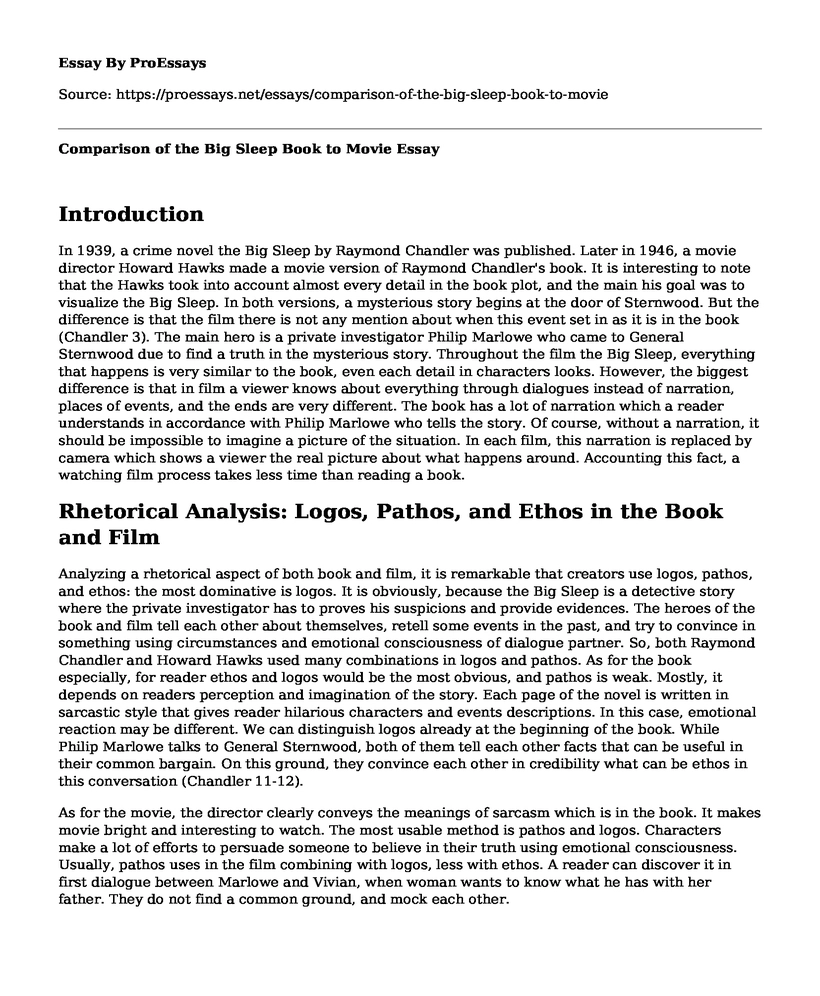Introduction
In 1939, a crime novel the Big Sleep by Raymond Chandler was published. Later in 1946, a movie director Howard Hawks made a movie version of Raymond Chandler's book. It is interesting to note that the Hawks took into account almost every detail in the book plot, and the main his goal was to visualize the Big Sleep. In both versions, a mysterious story begins at the door of Sternwood. But the difference is that the film there is not any mention about when this event set in as it is in the book (Chandler 3). The main hero is a private investigator Philip Marlowe who came to General Sternwood due to find a truth in the mysterious story. Throughout the film the Big Sleep, everything that happens is very similar to the book, even each detail in characters looks. However, the biggest difference is that in film a viewer knows about everything through dialogues instead of narration, places of events, and the ends are very different. The book has a lot of narration which a reader understands in accordance with Philip Marlowe who tells the story. Of course, without a narration, it should be impossible to imagine a picture of the situation. In each film, this narration is replaced by camera which shows a viewer the real picture about what happens around. Accounting this fact, a watching film process takes less time than reading a book.
Rhetorical Analysis: Logos, Pathos, and Ethos in the Book and Film
Analyzing a rhetorical aspect of both book and film, it is remarkable that creators use logos, pathos, and ethos: the most dominative is logos. It is obviously, because the Big Sleep is a detective story where the private investigator has to proves his suspicions and provide evidences. The heroes of the book and film tell each other about themselves, retell some events in the past, and try to convince in something using circumstances and emotional consciousness of dialogue partner. So, both Raymond Chandler and Howard Hawks used many combinations in logos and pathos. As for the book especially, for reader ethos and logos would be the most obvious, and pathos is weak. Mostly, it depends on readers perception and imagination of the story. Each page of the novel is written in sarcastic style that gives reader hilarious characters and events descriptions. In this case, emotional reaction may be different. We can distinguish logos already at the beginning of the book. While Philip Marlowe talks to General Sternwood, both of them tell each other facts that can be useful in their common bargain. On this ground, they convince each other in credibility what can be ethos in this conversation (Chandler 11-12).
As for the movie, the director clearly conveys the meanings of sarcasm which is in the book. It makes movie bright and interesting to watch. The most usable method is pathos and logos. Characters make a lot of efforts to persuade someone to believe in their truth using emotional consciousness. Usually, pathos uses in the film combining with logos, less with ethos. A reader can discover it in first dialogue between Marlowe and Vivian, when woman wants to know what he has with her father. They do not find a common ground, and mock each other.
Contrasting Endings: The Conclusion of the Story in the Book and Film
The end of the movie version of the Big Sleep is the most significant difference from the novel. In the las chapter of the book, a reader discovers conclusion of the story in Marlowe and Vivians dialogue. Marlowe visits General Sternwood and explains the true story of investigation blaming his daughter Carmen as guilty (Chandler 230). After it, Marlowe goes to the local bar, and orders several double Scotches. In contrast, the film is end by the murder of Eddie Mars at his house where Geiger lived. Marlowe and Vivian can skunk Mars and his fellows kill him. In the end, Marlowe tells Vivian what to do with Carmen and what to say her father. After all, he kisses her. As we see, the film more romantic than the book. It seems, Howard Hawks has the aim to bring more audience adding the happy end.
Work Cited
Chandler Raymond. The Big Sleep. New York: Alfred A. Knopf. 1976. 277 p.
Cite this page
Comparison of the Big Sleep Book to Movie. (2021, Mar 06). Retrieved from https://proessays.net/essays/comparison-of-the-big-sleep-book-to-movie
If you are the original author of this essay and no longer wish to have it published on the ProEssays website, please click below to request its removal:
- Enforcement of Surrogacy Contracts - Essay Sample
- What Is the Health Rhetorical Analysis - Essay Sample
- essay sample on application of technologies in music
- The Virgin and Child Painting Essay Example
- Essay Sample on Impact of the Point Of View in Alice Walker's "Everyday Use"
- Paper Example on Adjusted Families: Understanding External and Internal Influences
- Essay Example on Elizabeth Bishop: A Pioneer of American Modernism and Poetry







